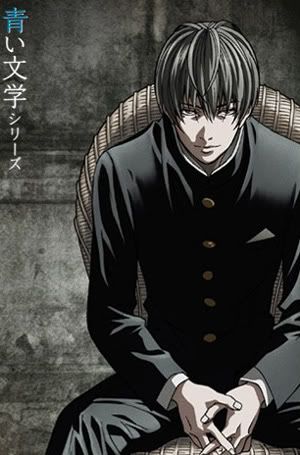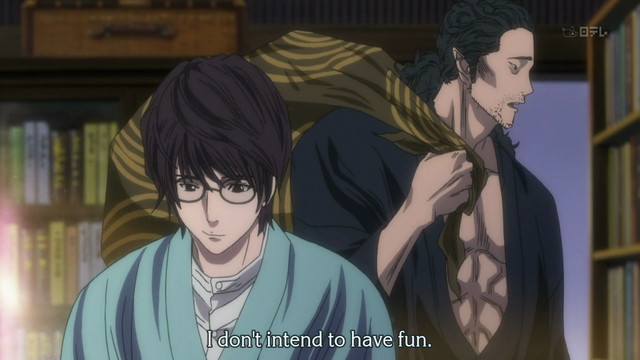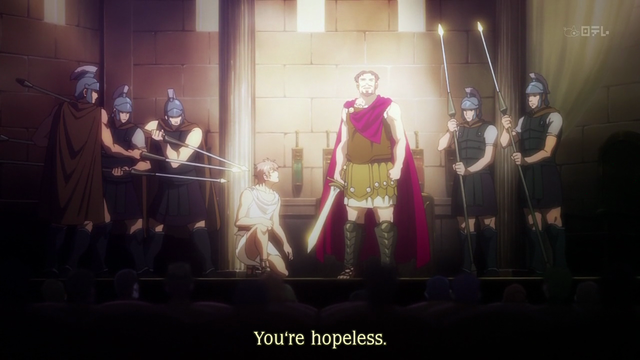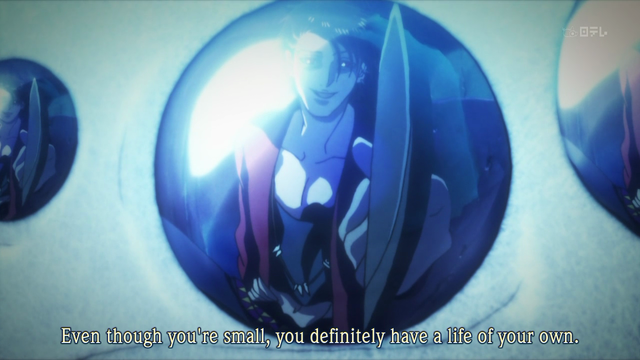Aoi Bungaku

Synopsis
The series consists of adaptations of six modern classics of Japanese literature: Osamu Dazai’s No Longer Human (Ningen Shikkaku) & Run, Melos! (Hashire, Melos!), Natsume Soseki’s Kokoro, Ryunosuke Akutagawa’s Hell Screen (Jigoku Hen) & The Spider's Thread (Kumo no Ito), and Ango Sakaguchi's In the Forest, Under Cherries in Full Bloom (Sakura no Mori no Mankai no Shita).
Episodes 1-4: No Longer Human - A high school student becomes lost and alienated. Despondent and aimless, he falls into a cycle of self abuse, depression and drugs that taints his life for years. Each episodes deals with a different point in his life, and the final episode leaves him standing alone - an empty and hollow charicature of his former self.
Episodes 5-6: In the Forest, Under Cherries in Full Bloom - A love story (and a horror story, too) about a 12th-century woman and a mountain bandit who abducts her.
Episodes 7-8: Kokoro - A 1914 tale of a young man's life journey during the Meiji era. The work deals with the transition from the Japanese Meiji society to the modern era, by exploring the friendship between a young man and an older man he calls "Sensei." It continues the theme of isolation developed in Soseki's previous works, here in the context of interwoven strands of egoism and guilt.
Episodes 9-10: Run, Melos! - An updated retelling of a classic Greek tale of the story of Damon and Pythias. The most prominent theme of "Run, Melos!" is unwavering friendship. Despite facing hardships, the protagonist Melos does his best to save his friend's life. The original myth is framed in a modern story about friendship betrayed and reclaimed.
Episode 11: The Spider's Thread - The Buddha Shakyamuni chances to notice a cold-hearted criminal suffering in Hell. But this criminal did perform one single act of kindness in not stepping on a spider in a forest. Moved by this selfless act, Shakyamuni takes the silvery thread of a spider in Paradise and lowers it down into Hell, but it falls upon the criminal to seize the opportunity and pull himself out - if he can.
Episode 12: Hell Screen - A famous artist is commissioned by the emperor to create a series of paintings depicting scenes from his country. But where the emperor beauty, the artist sees only corruption, evil, and death. Ultimately, the artist must pay an appalling price to maintain fidelity to his horrific vision.
Series Info
Year of release: 2009
Episodes: 12 (including two double episodes)
Categories: Horror, Seinen, Tragedy
Directors: Morio Asaka (eps 1-4) | Tetsuro Araki (eps 5-6) | Shigeyuki Miya (eps 7-8) | Ryosuke Nakamura (eps 9-10) | Atsuko Ishizuka (eps 11-12)
Production: Madhouse
File Info
Group: Masterpiece
Video: 1280x720 (16:9) 23.976 fps H264/AVC (1500 to 2500 kBit/s, depending on episode)
Audio: Japanese 2.0 Stereo AAC (160 to 200 kBit/s, depending on episode)
Subtitles: English styled softsubs (ASS/SSA)



Download Links
DDLA
***Note:ep 7-8 & 11-12 aren't included into DDLA.
Filefactory
Depositfiles

Synopsis
The series consists of adaptations of six modern classics of Japanese literature: Osamu Dazai’s No Longer Human (Ningen Shikkaku) & Run, Melos! (Hashire, Melos!), Natsume Soseki’s Kokoro, Ryunosuke Akutagawa’s Hell Screen (Jigoku Hen) & The Spider's Thread (Kumo no Ito), and Ango Sakaguchi's In the Forest, Under Cherries in Full Bloom (Sakura no Mori no Mankai no Shita).
Episodes 1-4: No Longer Human - A high school student becomes lost and alienated. Despondent and aimless, he falls into a cycle of self abuse, depression and drugs that taints his life for years. Each episodes deals with a different point in his life, and the final episode leaves him standing alone - an empty and hollow charicature of his former self.
Episodes 5-6: In the Forest, Under Cherries in Full Bloom - A love story (and a horror story, too) about a 12th-century woman and a mountain bandit who abducts her.
Episodes 7-8: Kokoro - A 1914 tale of a young man's life journey during the Meiji era. The work deals with the transition from the Japanese Meiji society to the modern era, by exploring the friendship between a young man and an older man he calls "Sensei." It continues the theme of isolation developed in Soseki's previous works, here in the context of interwoven strands of egoism and guilt.
Episodes 9-10: Run, Melos! - An updated retelling of a classic Greek tale of the story of Damon and Pythias. The most prominent theme of "Run, Melos!" is unwavering friendship. Despite facing hardships, the protagonist Melos does his best to save his friend's life. The original myth is framed in a modern story about friendship betrayed and reclaimed.
Episode 11: The Spider's Thread - The Buddha Shakyamuni chances to notice a cold-hearted criminal suffering in Hell. But this criminal did perform one single act of kindness in not stepping on a spider in a forest. Moved by this selfless act, Shakyamuni takes the silvery thread of a spider in Paradise and lowers it down into Hell, but it falls upon the criminal to seize the opportunity and pull himself out - if he can.
Episode 12: Hell Screen - A famous artist is commissioned by the emperor to create a series of paintings depicting scenes from his country. But where the emperor beauty, the artist sees only corruption, evil, and death. Ultimately, the artist must pay an appalling price to maintain fidelity to his horrific vision.
Series Info
Year of release: 2009
Episodes: 12 (including two double episodes)
Categories: Horror, Seinen, Tragedy
Directors: Morio Asaka (eps 1-4) | Tetsuro Araki (eps 5-6) | Shigeyuki Miya (eps 7-8) | Ryosuke Nakamura (eps 9-10) | Atsuko Ishizuka (eps 11-12)
Production: Madhouse
File Info
Group: Masterpiece
Video: 1280x720 (16:9) 23.976 fps H264/AVC (1500 to 2500 kBit/s, depending on episode)
Audio: Japanese 2.0 Stereo AAC (160 to 200 kBit/s, depending on episode)
Subtitles: English styled softsubs (ASS/SSA)



Download Links
DDLA
Code:
http://safelinking.net/p/6c5f237b54Filefactory
Code:
http://safelinking.net/p/1b18af2634Depositfiles
Code:
http://safelinking.net/p/c001a04214

